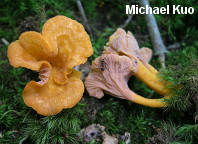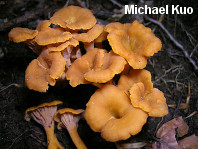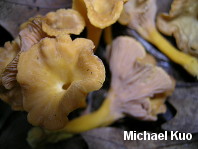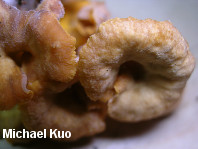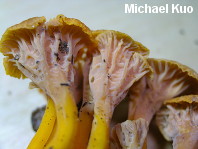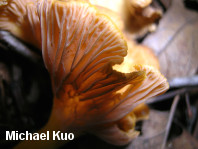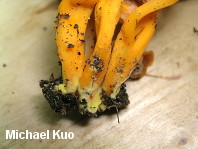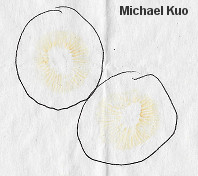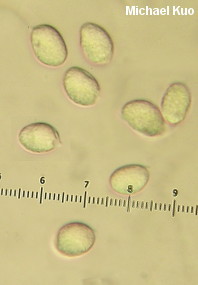| Major Groups > Chanterelles and Trumpets > Craterellus ignicolor |

|
Craterellus ignicolor [ Basidiomycota > Cantharellales > Cantharellaceae > Craterellus . . . ] by Michael Kuo Craterellus ignicolor is characterized by its small size, its fairly well developed false gills, which often develop pinkish shades with maturity--and its yellow-orange cap, which develops a perforation in its center and becomes vase-shaped. It grows in moss or in low, wet areas in hardwood forests in eastern North America. Compare with Craterellus tubaeformis, which grows in conifer forests and has a brown cap--and, if you are collecting in the Gulf Coast states, under slash pine, compare with Cantharellus tabernensis, which is initially brownish but fades to yellow or orange when mature. Cantharellus minor is also similar, but is smaller and does not develop a central perforation. Craterellus ignicolor was recognized as distinct by North American mycologists for just over a hundred years before it got its own species name. In New York, Peck (1873) called it Cantharellus lutescens, then later (1892) decided it should be Cantharellus infundibuliformis var. luteolus. In Michigan, Smith (1953) also called it Cantharellus lutescens at first, but later (1968) decided it was Cantharellus minor. In 1975, Ron Petersen described the fungus as a new species of Cantharellus, designating a type collection from Great Smoky Mountain National Park, in Tennessee. In 2000, DNA analysis by Dahlman and collaborators revealed the species should be placed in Craterellus rather than Cantharellus. Description: Ecology: Mycorrhizal with oaks, beech, and birches; growing gregariously or in clusters in moss or sphagnum in damp, shady areas; apparently widely distributed in eastern North America; summer and fall. The illustrated and described collections are from Illinois and Michigan. Cap: 1.5-5 cm wide; planoconvex when very young but soon developing a central depression and, eventually, becoming vase-shaped, with a perforated center; with a wavy and often irregular or scalloped margin at maturity; slightly moist when fresh, but soon dry; bald or, when young, with a canescent sheen from tiny, appressed, whitish fibrils; bright orange to orangish yellow or brownish yellow, fading with age to dull yellowish. Undersurface: With fairly well developed, thick, blunt false gills that run down the stem; becoming cross-veined; pale yellow to grayish at first, developing pinkish to faintly purplish hues at maturity and, eventually, becoming very pale tan. Stem: 2-6 cm long; 3-10 mm thick; equal or tapering to base; becoming hollow; bald, with a somewhat waxy texture; bright orange-yellow to orange; basal mycelium bright yellow. Flesh: Thin; whitish. Odor and Taste: Taste not distinctive; odor not distinctive, or slightly fruity. Spore Print: Pinkish yellow to yellow. Chemical Reactions: Iron salts grayish to negative on undersurface; negative on flesh. KOH negative on cap surface. Microscopic Features: Spores 9-12 x 6-8 µ ellipsoid; smooth; faintly ochraceous in KOH; with minutely granular contents; cyanophilous. Basidia 4-sterigmate; 65-75 µ long. Hymenial cystidia not found. Pileipellis not differentiated. Elements of upper surface 5-7.5 µ wide; hyaline in KOH; smooth; clamped at septa. REFERENCES: (Petersen, 1975) Dahlman, Danell & Spatafora, 2000. (Petersen, 1975; Bigelow, 1978; Smith, Smith & Weber, 1981; Phillips, 1991/2005; Lincoff, 1992; Dahlman et al., 2000; Miller & Miller, 2006; Kuo & Methven, 2014.) Herb. Kuo 09019503, 07260404, 06230907, 06221009. This site contains no information about the edibility or toxicity of mushrooms. |
© MushroomExpert.Com |
|
Cite this page as: Kuo, M. (2015, February). Craterellus ignicolor. Retrieved from the MushroomExpert.Com Web site: http://www.mushroomexpert.com/craterellus_ignicolor.html |
